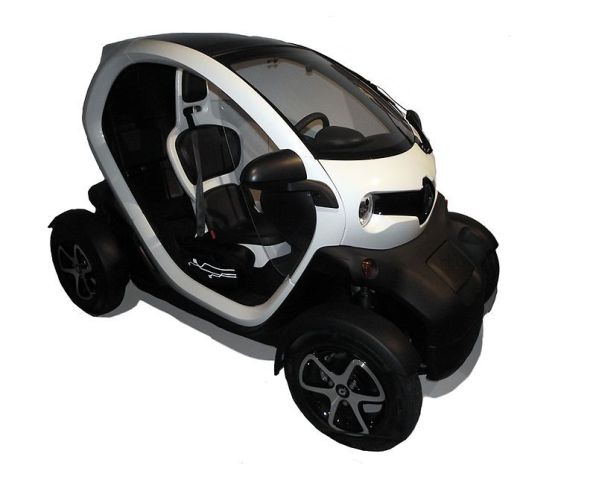
When polymers take the wheel
Full power with lithium-polymer batteries
First marketed in 1991 by Sony Energitech, the lithium-ion battery replaced the more polluting and less efficient nickel-metal hydride batteries in portable electronics before moving on to take over small vehicles such as electric bicycles. However, the automotive industry is now investing in developing this mode of energy storage due to its low weight.
The battery's functioning is based on the chemical reaction of positively-charged Li+ ions that flow between the battery's anode and cathode through the intermediary conductor elements, called the electrolyte, in order to store electrical energy or deliver it to a motor.
Most of the research carried out on electric vehicle batteries is aimed at improving this process: by increasing the number of cycles and stored power, and by reducing charging times and the risks linked to the presence of unstable and corrosive substances..
The Lithium-Polymer technology, and its variant the Lithium-Metal-Polymer technology, adopted by French manufacturer Bolloré, is one of the most promising alternatives. These batteries manufactured in the form of flexible multi-layer films combining solid lithium with a polyethylene or polyacrylonitrile electrolyte are lighter and safer. However, although they offer improved energy density, they have to be maintained at temperatures between 60 and 80 °C and therefore constantly consume energy, even when the vehicle is stationary.
This drawback could soon be a thing of the past thanks to more efficient batteries with thin "block copolymer" sheets developed in Grenoble as part of the SIEL (Single-Ion Electrolyte) project.
A composite body to recharge batteries
The Volvo Car Group developed a revolutionary new concept for storing energy in a vehicle's body, doing away with cumbersome batteries and reducing the vehicle's weight.
The concept is based on a multi-layer material combining a polymer-carbon fibre composite, accumulators in the form of nanoparticles and supercapacitors that can be moulded into body parts such as door and boot panels and the vehicles’ wings.
Functioning as a battery, this capacitor material can be charged from an electrical outlet or by recovering energy during deceleration and braking. Once charged, it can take over from the main batteries and power the electric vehicle or any other part of its equipment.
Volvo is currently testing its new technology on two parts of the Volvo S80's body: the luggage trunk lid and a point located under the hood, at the base of the windscreen wipers in the engine compartment. According to Volvo, a body equipped with this technology can be charged faster than a traditional battery while remaining flexible and resistant.
Plastics put on a show
Spearheading the reduction of an automobile’s structural weight, plastics are tentatively moving into the machine’s gears. Daimler did not hesitate to incorporate the first ever plastic engine mount into its new GL Class Mercedes. This part has to be able to withstand the weight of the engine and many other stresses. It has to resist continuous weak shocks or, on otherwise, collapse quickly in the event of a head-on collision in order to prevent the engine forcefully entering the driver’s compartment. The new polyamide part can meet these constraints with as much ease as the aluminium version used until recently.
Better yet, it has better sound dampening and thermal insulation properties and weighs 30% less besides.
Although the use of composites in suspension is far from widespread, the battle for weight reduction is nevertheless being waged in this area too. The glass fibre-reinforced polymer coil springs of the Audi R8 are likely to turn up in the brand's other models. And for good reason, since these springs are 40% lighter, they are insensitive to rust and they are less complex to produce than their iron counterparts. These two advantages of plastics also incited Volvo and Peugeot to equip their 4X4 XC90 and 208 Hybrid FE, respectively, with a transverse blade made of composite materials, simultaneously acting as lower wishbones, suspension springs and anti-roll bar.
Freewheeling plastics
At the 2004 Paris Motor Show, Michelin was already showing off "airless tires". Ten years later, the company has made the idea a reality in the United States. The new tire is currently produced under the name "X Tweel" and in the form of a rigid hub connected to a shear beam by means of flexible, deformable polyurethane spokes. Functioning without air, this non-tire is currently used only for small agricultural and construction vehicles and is a first unstoppable response to the risk of punctures.
In this area, Bridgestone is hot on the heels of Michelin. The Japanese manufacturer showed off an "airless tire" prototype based on a structure of thermoplastic resin spokes at the 2011 Tokyo Motor Show, followed by a new version christened "Air Free Concept" unveiled in 2013 and also intended for vehicles weighing less than 200 kg.
On another note entirely, Goodyear showed off a tire able to transform the energy produced by driving into electricity to recharge the vehicle's batteries or to power the on-board equipment during the Geneva Motor Show in March. Known under the code name "BH03", this tire generates electricity through the combined action of two types of material: a thermoelectric material and a piezoelectric material that convert the heat generated by the tire and its deformation, respectively, into electricity.





